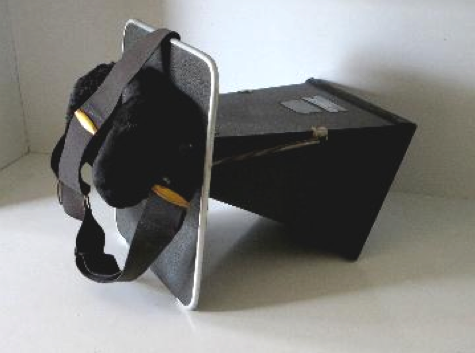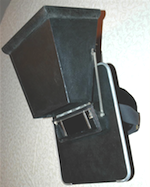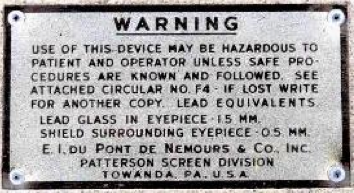Patterson Operating Fluoroscope
Ref. J3




Soon after Roentgen announced his discovery of X-rays in January 1896, a hand-held fluoroscopic device was announced by different inventors under different names: “Cryptoscope” by Enrico Salvioni, “Skiascope” by William Francis Magie, and “Vitascope” by Thomas Edison, who preferred later to call it “Fluoroscope”, a name widely adopted thereafter in English speaking countries.
The “Patterson Operating Fluoroscope” was introduced late in the 2nd decade or early 3rd decade of last century, but the device shown and which I presume to be of the mid- or late forties, was made by E.I. du Pont De Nemours & Co. Inc. who had acquired the “Patterson” screen business in 1943.
It was described as a “small darkroom adapted to the operator’s eyes and fitted with a fluorescent screen” It could be fixed with straps to the operator’s head, leaving the hands free. The main body of the device could be swung upwards on hinges and maintained in this position by springs. When in this position, a red glass filter flips optionally in front of the lead glass protective eye-piece in order to maintain the dark adaptation of the operator’s eyes.
The “Patterson Type B” fluorescent screen in this unit, measuring about 5.5 x 7.5” (14 x 19 cm), lies right behind the bakelite front. The fluorescent material (cadmium tungstate) is coated on a cardboard support covered by a sheet of celluloid. The use of glass at the front end of the unit has been avoided, keeping the device, with its actual weight of about 4 lbs (1.8 Kg), light enough to be strapped to the operator’s head.
In the early fifties I have seen this device still in use in orthopedic practice. However, already in 1965, E.R.N.Grigg wrote: “The appliance is hopelessly obsolete by any standards of radiation protection”. (The Trail of the Invisible Light).